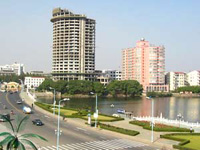
The half-finished buildings abandoned by developers, known as lanweilou in Chinese, or rotten-tail buildings, used to be the ugly scars on Shanghai's landscape.
It is estimated that at the peak, about 600 half-finished buildings were left after the property boom in the mid-1990s was followed by the Asian financial crisis a few years later. About 10 billion yuan (US$1.2 billion) capital was sunk in these derelict buildings.
Wu Jiang, deputy director of Shanghai Urban Planning Bureau, used to be perturbed by the bleak cityscape.
Scars on cityscape
"Indeed, these buildings largely ruined the city's image, and gave urban planners a headache," Wu says.
Even worse, the property collapse added huge amounts to banks' bad-loan portfolios as most of such construction projects were dependent on bank borrowings.
Each district then established special offices to facilitate the completion of these projects, but not much was accomplished in the beginning.
However, things started to take a turn for the better when Shanghai's real-estate market started to boom and land was no longer easily available.
"As Shanghai's real estate market heats up and less land is available for new projects, developers are turning to the half-finished buildings," says Yu Dandan, director of Sincere Real Estate Research Center.
The Shanghai Housing Index, the benchmark for the city's new-housing prices, rose 33 percent last year; and prices are likely to continue spiraling upward.
Meanwhile, as the government leased too much land in the 1990s, little is left available in the city proper. As real-estate companies from around the country rush to the city, land prices are being pushed higher. It is estimated that land prices in the downtown area have tripled in the past few years.
The amount of land to be tendered in central districts will fall in years to come, as the city opts to release more in outlying areas to build more lower-income housing and reserve more land for public space and green belts.
So developers turned their attention to the incomplete buildings -- Shanghai International Commodity Auction Co Ltd, the city's leading auction house, has witnessed the trend in the past few years as it has auctioned more than a dozen half-finished buildings.
From January 2001 to May 2002, it auctioned 11 unfinished projects with a total floor space of 229,620 square meters valued at 280 million yuan (US$34 million).
Last year, it pulled off several headline-making deals including a half-finished office building abandoned for seven years, which was sold at 470 million yuan (US$57 million), 20.5 percent higher than its initial bidding price.
Fan Ganping, vice-president of the auction house, said that there are several factors working together to revive these buildings.
"State-owned banks are accelerating their process of writing off bad loans, courts are taking an active part in dealing with cases which involve such buildings," he says.
Developers, however, have their own calculations.
Most of these lanweilous are located in the city center, namely Shanghai's most valuable real estate. Renovation of such buildings requires only six months to a year, much shorter than starting from scratch for a brand new project.
Architectural conversion
As residential projects are generally more profitable than office buildings, usually 20 to 50 percent higher, many developers renovate those half-finished buildings into studio or service apartments, as well as small offices.
It is estimated that about 80 percent of studio flats which emerged in the past two years were actually converted from unfinished office buildings.
All the renovated projects received overwhelming response from the market, Fan says, adding that his company will host auctions for a handful of such projects this year, each involving more than 100 million yuan (US$12 million).
Most of the unfinished buildings up for bidding are court-ordered sales.
Meanwhile, the government is also taking measures to tackle the problem but there are still around 200 buildings left untouched.
"Almost all derelict buildings have a complicated story behind them, especially regarding capital and credit issues," Yu, the researcher, says.
Also, the unsold properties could be less attractive in terms of location, construction and capital demand, compared with those which have found buyers; and some experts worry that they would be the most difficult to tackle.
Drawing from his experience with over a dozen half-finished projects, Fan says developers should keep a cool head while investing in these buildings.
"Careful study on both the capital side and market side should be done before taking up the project," he says.
Both Fan and Yu say the problem requires great attention from the government.
(China Daily February 27, 2004)
|

